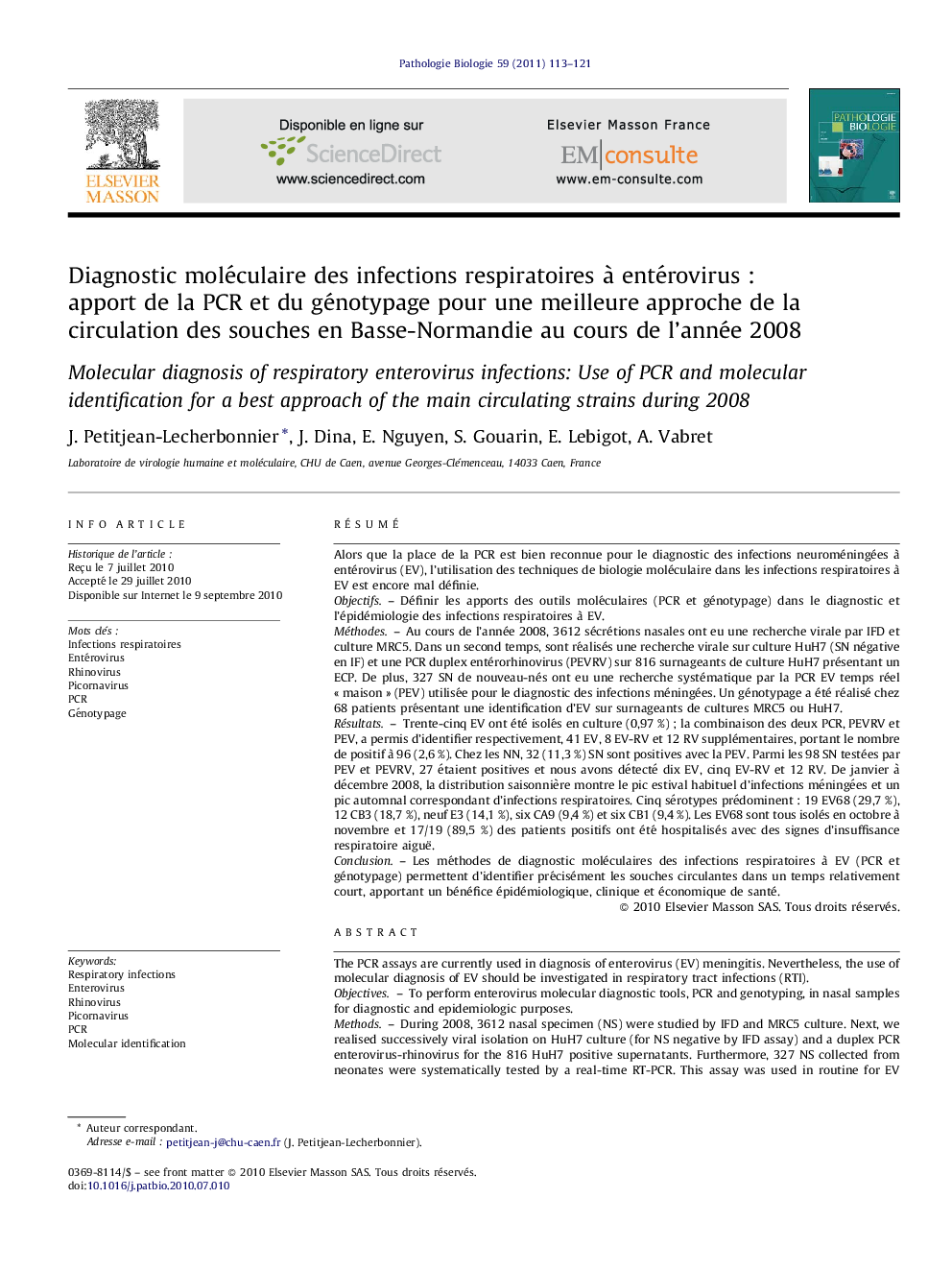| کد مقاله | کد نشریه | سال انتشار | مقاله انگلیسی | نسخه تمام متن |
|---|---|---|---|---|
| 4136405 | 1271913 | 2011 | 9 صفحه PDF | دانلود رایگان |

RésuméAlors que la place de la PCR est bien reconnue pour le diagnostic des infections neuroméningées à entérovirus (EV), l’utilisation des techniques de biologie moléculaire dans les infections respiratoires à EV est encore mal définie.ObjectifsDéfinir les apports des outils moléculaires (PCR et génotypage) dans le diagnostic et l’épidémiologie des infections respiratoires à EV.MéthodesAu cours de l’année 2008, 3612 sécrétions nasales ont eu une recherche virale par IFD et culture MRC5. Dans un second temps, sont réalisés une recherche virale sur culture HuH7 (SN négative en IF) et une PCR duplex entérorhinovirus (PEVRV) sur 816 surnageants de culture HuH7 présentant un ECP. De plus, 327 SN de nouveau-nés ont eu une recherche systématique par la PCR EV temps réel « maison » (PEV) utilisée pour le diagnostic des infections méningées. Un génotypage a été réalisé chez 68 patients présentant une identification d’EV sur surnageants de cultures MRC5 ou HuH7.RésultatsTrente-cinq EV ont été isolés en culture (0,97 %) ; la combinaison des deux PCR, PEVRV et PEV, a permis d’identifier respectivement, 41 EV, 8 EV-RV et 12 RV supplémentaires, portant le nombre de positif à 96 (2,6 %). Chez les NN, 32 (11,3 %) SN sont positives avec la PEV. Parmi les 98 SN testées par PEV et PEVRV, 27 étaient positives et nous avons détecté dix EV, cinq EV-RV et 12 RV. De janvier à décembre 2008, la distribution saisonnière montre le pic estival habituel d’infections méningées et un pic automnal correspondant d’infections respiratoires. Cinq sérotypes prédominent : 19 EV68 (29,7 %), 12 CB3 (18,7 %), neuf E3 (14,1 %), six CA9 (9,4 %) et six CB1 (9,4 %). Les EV68 sont tous isolés en octobre à novembre et 17/19 (89,5 %) des patients positifs ont été hospitalisés avec des signes d’insuffisance respiratoire aiguë.ConclusionLes méthodes de diagnostic moléculaires des infections respiratoires à EV (PCR et génotypage) permettent d’identifier précisément les souches circulantes dans un temps relativement court, apportant un bénéfice épidémiologique, clinique et économique de santé.
The PCR assays are currently used in diagnosis of enterovirus (EV) meningitis. Nevertheless, the use of molecular diagnosis of EV should be investigated in respiratory tract infections (RTI).ObjectivesTo perform enterovirus molecular diagnostic tools, PCR and genotyping, in nasal samples for diagnostic and epidemiologic purposes.MethodsDuring 2008, 3612 nasal specimen (NS) were studied by IFD and MRC5 culture. Next, we realised successively viral isolation on HuH7 culture (for NS negative by IFD assay) and a duplex PCR enterovirus-rhinovirus for the 816 HuH7 positive supernatants. Furthermore, 327 NS collected from neonates were systematically tested by a real-time RT-PCR. This assay was used in routine for EV diagnosis setting in cerebrospinal fluid. Enterovirus genotyping was then performed for the 68 positive supernatants.ResultsThirty-five NS (0.97%) were positive for EV by culture (MRC5). A combination of both PCR assays, PEVRV and PEV, allowed an additional identification of 41 EV, eight EV-RV and 12 RV, increasing the number of positive to 96 NS (2.6%). Among the neonates, 32 NS (11.3%) were positive for EV by PEV. Of the 98 NS tested by the two PCR assays (PEV and PEVRV), 27 were positive and we detected 10 EV, five EV-RV and 12 RV. From January to December 2008, the circulation of EV showed the usual peak in June–July when a small outbreak of aseptic meningitis occurred and an additional autumnal peak corresponding to respiratory tract infections. Five main serotypes were isolated: 19 EV68 (29.7%), 12 CB3 (18.7%), nine E3 (14,1%), six CA9 (9.4%) and six CB1 (9.4%); the 19 EV68 were isolated in October–November and 17/19 (89.5%) of positive patients were hospitalised for severe respiratory diseases.ConclusionThe use of molecular screening techniques (PCR assays and genotyping) on nasal samples collected from patients with respiratory infections allowed a prospective, effective and precise identification of circulating strains.
Journal: Pathologie Biologie - Volume 59, Issue 2, April 2011, Pages 113–121